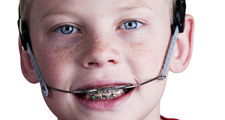
Child Orthodontics
Parents should be aware that children as young as five may benefit from visiting an orthodontist or a child orthodontics specialist for evaluation. While orthodontic treatment on a patient this young is unusual, preventative treatment may be in the best interest of the child.
By the age of seven, most children have a blend of primary teeth and permanent adult teeth that are possibly crowded, irregularly spaced, protruding to absent altogether. Although some malocclusions (bad bites) are inherited, others are acquired over time due to finger-sucking, mouth breathing, periodontal disease, poor dental hygiene, early or late loss of baby teeth, irregular swallowing, trauma or poor nutrition.
Orthodontists can detect subtle problems with jaw growth and emerging teeth--early detection allows these problems to be corrected more readily. For this reason, the American Association of Orthodontists suggests that all children undergo a pediatric orthodontics evaluation no later than the age of seven. Upon detecting a problem, an orthodontist will most likely take a "wait-and-see" approach, periodically checking the child's teeth as permanent teeth emerge and facial bones develop.


